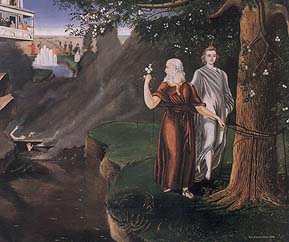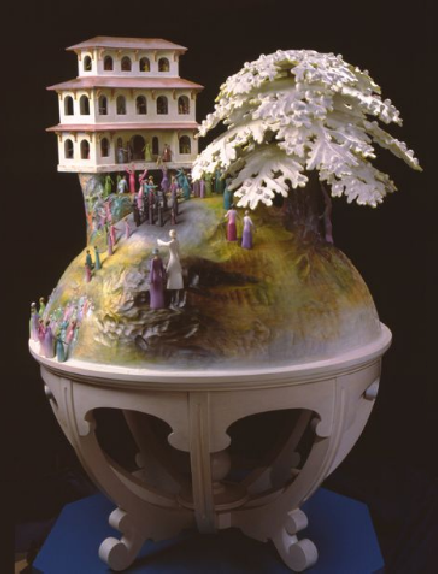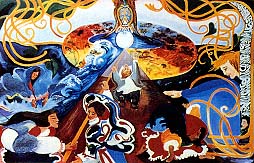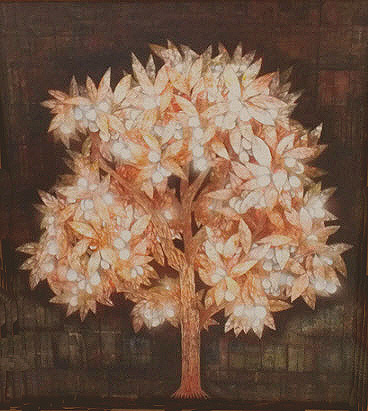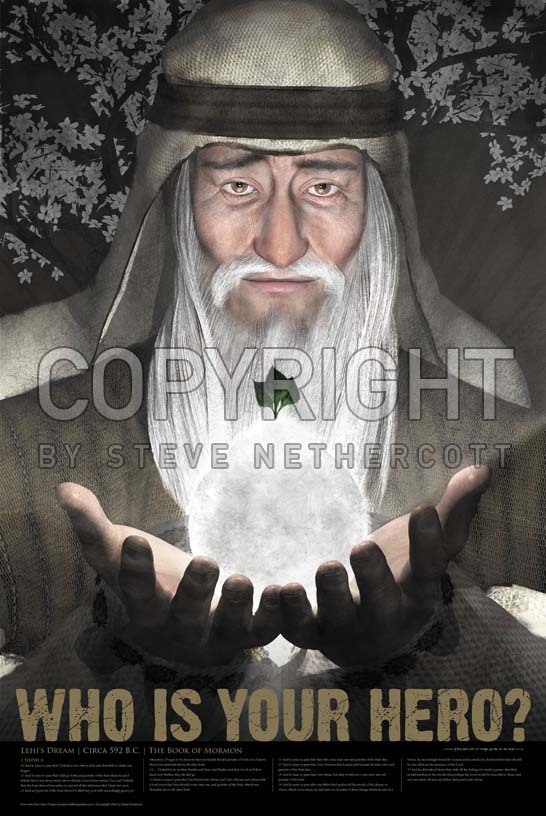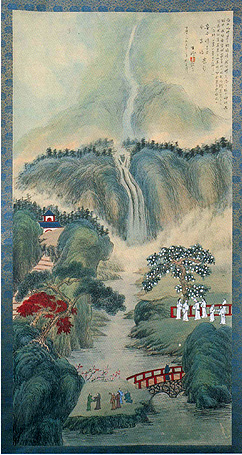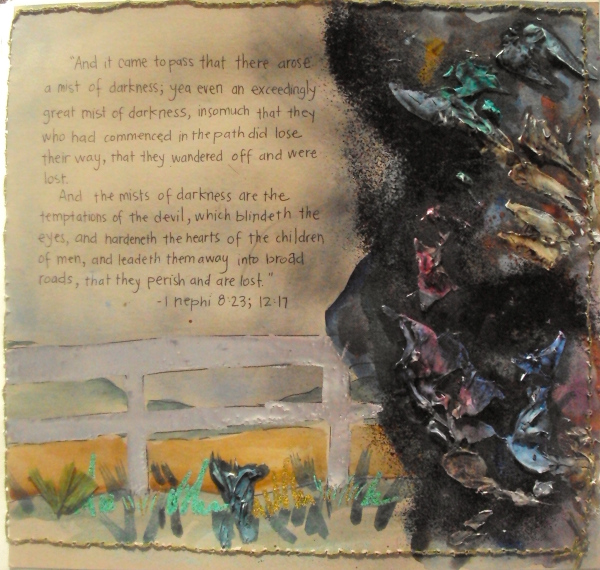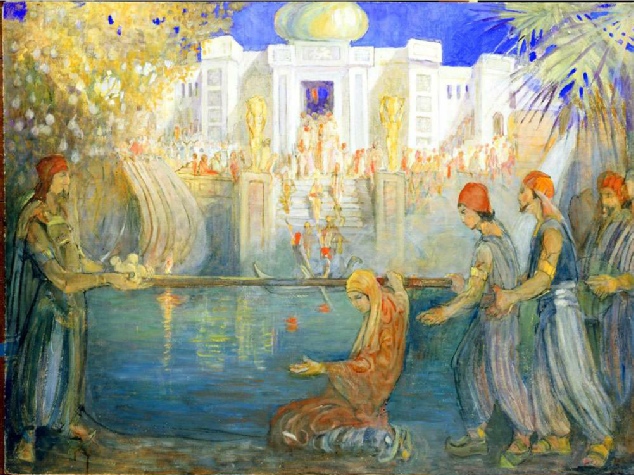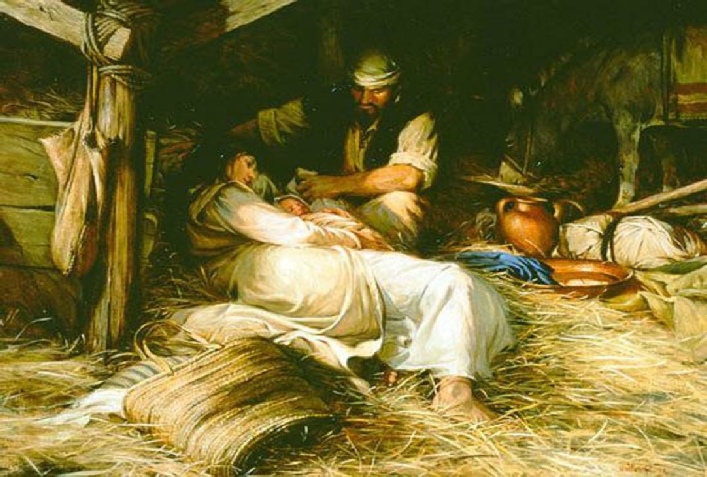






Book of Mormon Feast

An Artistic Tour of 1 Nephi 8-11
1 Nephi 8
BOOK OF MORMON MUSIC
“The Iron Rod” – Joseph L. Townsend & William Clayson
In Lehi’s powerful and visually descriptive vision of the Tree of Life, he saw an iron rod that led to the tree. The iron rod is the word of God, and “whoso would hearken unto the word of God, and would hold fast unto it, they would never perish; neither could the temptations and the fiery darts of the adversary overpower them unto blindness, to lead them away to destruction.”
A Priesthood Choir from BYU, under the direction of Ronald Staheli, performed “The
Iron Rod” at the Priesthood Session of the April 2010 General Conference of the Church
of Jesus Christ of Latter-
1 Nephi 8:2
BOOK OF MORMON ART
“Behold, I have dreamed a dream, or in other words, I have seen a vision.”
Thus Lehi introduces one of the most memorable and spiritually impressive scenes in the Book of Mormon, now referred to as the Tree of Life vision.
This Liahona article combines a number of beautiful interpretations by various artists of Lehi’s Tree of Life vision.
1 Nephi 8:5
BOOK OF MORMON ART
Lehi’s Dream
David Hyrum Smith
about 1875. oil on canvas (61 x 45 cm).
The artist was born a few months after his father, the Prophet Joseph Smith, was martyred in 1844.
In the painting, Lehi is accompanied by the “Spirit of the Lord” (see 1 Ne. 8:5–6; 1 Ne. 11:11).
(Courtesy of Reorganized Church of Jesus Christ of Latter Day Saints Archives, Independence, Missouri; photograph by R. T. Clark.)
1 Nephi 8:9
BOOK OF MORMON CARVED WOOD
Lehi’s Dream of the tree of Life
Kurt Sjökvist, 1995, Mockfjärd, Sweden
Carved wood, painted (157 x 101 x 101 centimeters).
Lehi’s reference to “a large and spacious field, as if it had been a world” is interpreted as a globe upon which the allegory is presented. (Photo by R. T. Clark, Museum of Church History and Art.)
1 Nephi 8:10
BOOK OF MORMON ART
Joseph Smith and the Tree of Life
Juan M. Escobedo
1987, Caliente, Nevada, United States; oil on board (127 x 76 cm).
The Prophet Joseph Smith leads the way in this Mexican folk art interpretation of the tree of life.
1 Nephi 8:10
BOOK OF MORMON SCULPTURE BLACK-
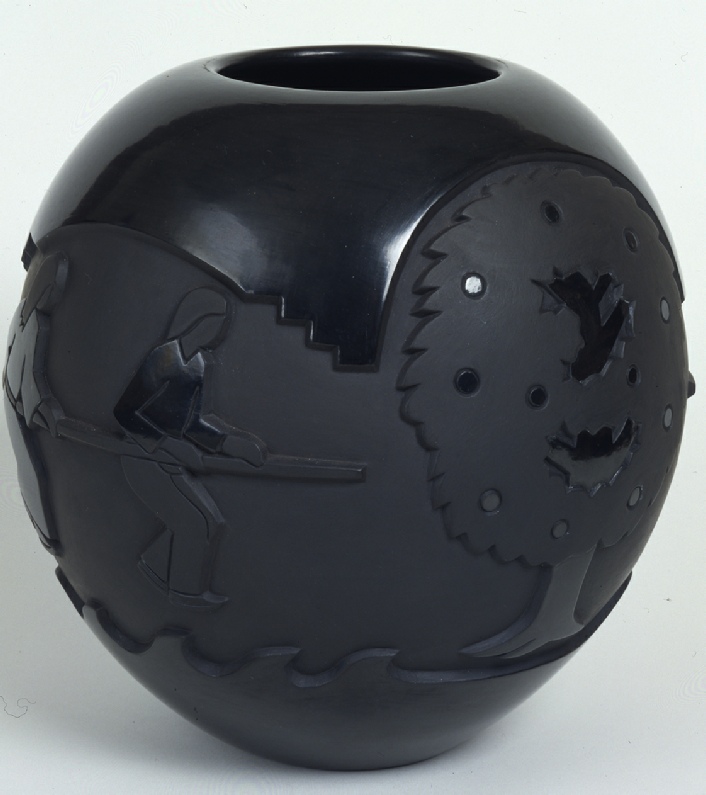
Harrison Begay Jr.-
Navajo Indian artist (1914-
1994, Espanola, New Mexico, United States
(23 x 18 x 18 cm).
1 Nephi 8:11
BOOK OF MORMON ART
Kazuto Uota
This stunning artistic work by Kazuto Uota was created in 1990. It represents the Tree of Life as described in the Book of Mormon, with its fruit glowing as it displays the power of God.
This work was featured on the cover of the Ensign magazine in August, 2010, and generated much favorable response from the Ensign readers.
1 Nephi 8:11,12
BOOK OF MORMON ART
Real Heroes Poster – Steve Nethercott
Speaking of the fruit of the Tree of Life, which represents the love of God, Lehi said, “I did go forth and partake of the fruit. . . it was most sweet . . . . It filled my soul with exceedingly great joy.”
Real people – real power. Real Hero Posters strives to capture the spirit of real heroes, the uniqueness of their world, the strength of their character, and the reality of their heroism.
1 Nephi 8:12
Xiu Wang
Chang-
Tempera on silk (170 x 68 cm).
This “mountain water” style of painting focuses on the joy of sharing the gospel with one’s family. The inscription quotes 1 Nephi 8:12
1 Nephi 8:16
BOOK OF MORMON ART
Lehi’s Dream – Gary L. Kapp
Lehi’s vision of the Tree of Life is a memorable high-
Speaking of a part of them, the Book of Mormon records, “And it came to pass that they did come unto me and partake of the fruit also.”
1 Nephi 8:16
BOOK OF MORMON ART
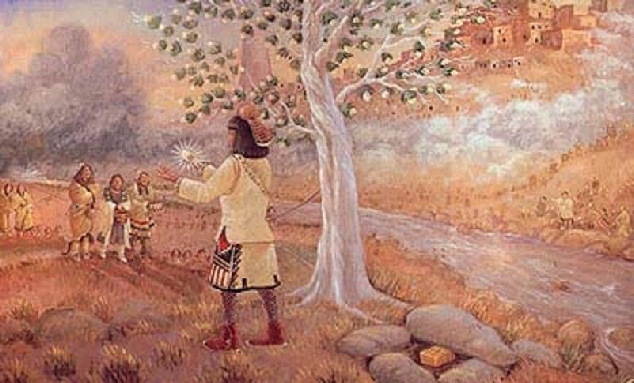
Lehi’s Vision of the Tree of Life
Robert Yellowhair, Snowflake, Arizona, United States
Oil on canvas (121 x 76 cm). 1992.
The artist uses traditional symbols to express his belief that Native Americans are
descendants of Lehi. Brother Yellowhair, a Navajo from the Zuni clan, has adapted
the essential themes of Lehi’s dream of the tree of life to a Native American setting.
A piñon tree, brilliant with light, symbolizes the tree of life; the pine cones are
the white fruit. Father Lehi is dressed as a Hopi priest because Hopis are acknowledged
among Native Americans of the Southwest as the traditional religious leaders. Sariah
is depicted as Crow Mother, the first mother of the Zuni. Nephi, on his mother’s
right, is depicted as the visionary Comanche chief, Quainapaker, from the early twentieth
century. Sam is depicted as the great peace-
1 Nephi 8:21
BOOK OF MORMON ART
Victoria, British Columbia, Canada
Beeswax on rice paper (71 x 61 cm).
The artist suggests that some who set out for the fruitful tree of life may be lured toward barren trees shown at the right of the print.
1 Nephi 8:23
BOOK OF MORMON ART
That Good Part blogger has illustrated Lehi’s dream with a dozen multi-
1 Nephi 8:26,27
BOOK OF MORMON ART
Minerva Teichert
Lehi and Nephi saw the beautifully symbolic Tree of Life in vision, which represents the Love of God. The also saw a great and spacious building, filled with people mocking those who were partaking of the pure fruit of the Tree.
“In this representation of Lehi’s Dream from chapter 8 of the first book of Nephi, Teichert reverses traditional symbolism of light and dark. As in real life, the blessings of faith and obedience are sometimes not as immediately apparent or attractive as the entrapments of Satan.”
1 Nephi 11
BOOK OF MORMON MUSIC
“Nephi’s Vision of the Tree of Life” – Marilyn Arnold & Maurine Ozment
Sacred Hymns of the Book of Mormon, 18
After Lehi told his family of his amazing and wonderful vision of the Tree of Life, his son Nephi wanted to see the things that his father had seen. Because of his faith and faithfulness, the Lord blessed him with this desire, and he wrote extensively of the marvelous things he himself saw, all of which testify of the love of God.
1 Nephi 11:20,21
BOOK OF MORMON ART
Bearing a Child in Her Arms {Mary and the Christ Child}
Elspeth Young
Artist’s comments:
The story behind Bearing A Child In Her Arms
This painting represents a portion of the vision the prophet Nephi received concerning the life and mission of Jesus Christ "to bear record that he is the son of God" (1 Nephi 11:7).
After being shown the tree of life, Nephi requested to know the interpretation of that tree. Accordingly, Nephi was immediately shown a vision of a "virgin...bearing a child in her arms" and was told that that the infant was "the Lamb of God, yea, even the Son of the Eternal Father!" (1 Nephi 11:18, 21).
Upon seeing this, an angel questioned Nephi concerning the meaning of the tree of
life. Nephi accurately perceived that the tree of life, or Christ, "is the love of
God, which sheddeth itself abroad in the hearts of the children of men; wherefore,
it is the most desirable above all things...and the most joyous to the soul" (1 Nephi
11:22-
Indeed, the love of God has never been manifested so plainly to God's children as in the gift of His "only begotten Son, that whosoever believeth in him should not perish, but have everlasting life" (John 3:16).
This visual representation of this moment from Nephi's marvelous vision seeks also to testify of the reality and divinty of the Son of God.
Symbolism in Bearing A Child In Her Arms
The figures of Mary and the Infant Christ are depicted very clearly in the midst of an indistinct background. As befits Nephi's unwavering focus during the vision, there is nothing in the background to distract the viewer from the message in the vision. All elements, even color and light, point to the center of our existence, Jesus Christ, just as the Spirit of the Lord makes it clear to Nephi that the reason he was shown what his father saw was so that he could bear his own witness of Christ.
The Child is loosely wrapped in the type of "swaddling clothes" in which Mary wrapped
Him at His birth (see Luke 2:7). Other than the barest hint of a golden trim at the
edge of the garment, there is nothing distinctive about the cloth, save its whiteness.
Its brilliance symbolizes His purity-
The viewer is drawn to the Infant's penetrating gaze by the highlight in His eye,
contrasted with the dark shadows surrounding Him. Though partly enveloped in the
shadows of this world, His light is ever invincible. His mission was to descend below
all things and overcome the world-
Mary's countenance is also radiant, partly from the Heavenly light enveloping the two figures; partly reminding the viewer of Nephi's description her as "exceedingly fair and white...most beautiful and fair above all other virgins" (1 Nephi 11:13, 15). Her beauty borne of goodness is also echoed in the words of Alma, who called her "a precious and chosen vessel" (Alma 7:10).
Mary's hair is seen unveiled, a visual representation of her virginity. In her day, it was customary for maidens to show their hair in public as a sign of their chastity. This, among other cultural clues of apparel may have helped Nephi identify her as a virgin without any help from the angel.
Mary's dress is patterned on traditional Palestinian dress, or shinyar, a costume silhouette dating back 1500 BC. The embroidered ornamentation on its yoke and sleeves is typical of Israelite bridal costume, though it is intended here as another visual symbol of elements in Nephi's vision. The golden motifs embroidered on its sleeves are a tree of life symbol, while the red and gold banding beneath the trees represent the rod of iron which Nephi beheld leading, "to the fountain of living waters, or to the tree of life" (1 Nephi 11:25).
The vessel immediately behind the figures is an oil cask symbolizing the Savior's
mission as the Anointed One, sent to earth to "heal the broken-
BOOK OF MORMON ART
Walter Rane
Commissioned.
